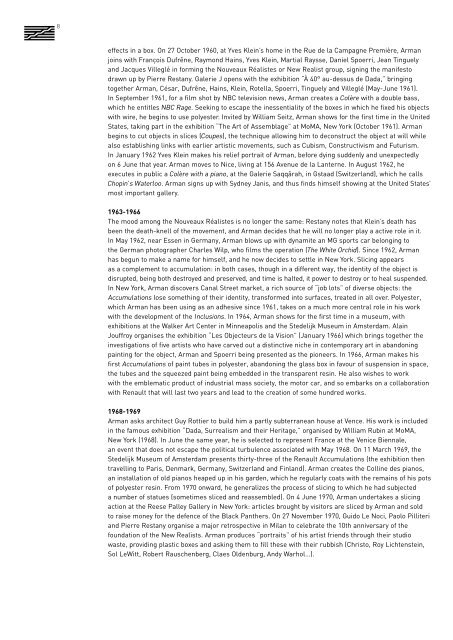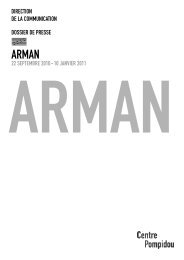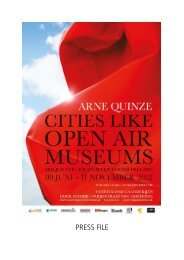Arman - Vicky David Gallery
Arman - Vicky David Gallery
Arman - Vicky David Gallery
You also want an ePaper? Increase the reach of your titles
YUMPU automatically turns print PDFs into web optimized ePapers that Google loves.
8<br />
effects in a box. On 27 October 1960, at Yves Klein’s home in the Rue de la Campagne Première, <strong>Arman</strong><br />
joins with François Dufrêne, Raymond Hains, Yves Klein, Martial Raysse, Daniel Spoerri, Jean Tinguely<br />
and Jacques Villeglé in forming the Nouveaux Réalistes or New Realist group, signing the manifesto<br />
drawn up by Pierre Restany. Galerie J opens with the exhibition “À 40° au-dessus de Dada,” bringing<br />
together <strong>Arman</strong>, César, Dufrêne, Hains, Klein, Rotella, Spoerri, Tinguely and Villeglé (May-June 1961).<br />
In September 1961, for a film shot by NBC television news, <strong>Arman</strong> creates a Colère with a double bass,<br />
which he entitles NBC Rage. Seeking to escape the inessentiality of the boxes in which he fixed his objects<br />
with wire, he begins to use polyester. Invited by William Seitz, <strong>Arman</strong> shows for the first time in the United<br />
States, taking part in the exhibition “The Art of Assemblage” at MoMA, New York (October 1961). <strong>Arman</strong><br />
begins to cut objects in slices (Coupes), the technique allowing him to deconstruct the object at will while<br />
also establishing links with earlier artistic movements, such as Cubism, Constructivism and Futurism.<br />
In January 1962 Yves Klein makes his relief portrait of <strong>Arman</strong>, before dying suddenly and unexpectedly<br />
on 6 June that year. <strong>Arman</strong> moves to Nice, living at 156 Avenue de la Lanterne. In August 1962, he<br />
executes in public a Colère with a piano, at the Galerie Saqqârah, in Gstaad (Switzerland), which he calls<br />
Chopin’s Waterloo. <strong>Arman</strong> signs up with Sydney Janis, and thus finds himself showing at the United States’<br />
most important gallery.<br />
1963-1966<br />
The mood among the Nouveaux Réalistes is no longer the same: Restany notes that Klein’s death has<br />
been the death-knell of the movement, and <strong>Arman</strong> decides that he will no longer play a active role in it.<br />
In May 1962, near Essen in Germany, <strong>Arman</strong> blows up with dynamite an MG sports car belonging to<br />
the German photographer Charles Wilp, who films the operation (The White Orchid). Since 1962, <strong>Arman</strong><br />
has begun to make a name for himself, and he now decides to settle in New York. Slicing appears<br />
as a complement to accumulation: in both cases, though in a different way, the identity of the object is<br />
disrupted, being both destroyed and preserved, and time is halted, it power to destroy or to heal suspended.<br />
In New York, <strong>Arman</strong> discovers Canal Street market, a rich source of “job lots” of diverse objects: the<br />
Accumulations lose something of their identity, transformed into surfaces, treated in all over. Polyester,<br />
which <strong>Arman</strong> has been using as an adhesive since 1961, takes on a much more central role in his work<br />
with the development of the Inclusions. In 1964, <strong>Arman</strong> shows for the first time in a museum, with<br />
exhibitions at the Walker Art Center in Minneapolis and the Stedelijk Museum in Amsterdam. Alain<br />
Jouffroy organises the exhibition “Les Objecteurs de la Vision” (January 1966) which brings together the<br />
investigations of five artists who have carved out a distinctive niche in contemporary art in abandoning<br />
painting for the object, <strong>Arman</strong> and Spoerri being presented as the pioneers. In 1966, <strong>Arman</strong> makes his<br />
first Accumulations of paint tubes in polyester, abandoning the glass box in favour of suspension in space,<br />
the tubes and the squeezed paint being embedded in the transparent resin. He also wishes to work<br />
with the emblematic product of industrial mass society, the motor car, and so embarks on a collaboration<br />
with Renault that will last two years and lead to the creation of some hundred works.<br />
1968-1969<br />
<strong>Arman</strong> asks architect Guy Rottier to build him a partly subterranean house at Vence. His work is included<br />
in the famous exhibition “Dada, Surrealism and their Heritage,” organised by William Rubin at MoMA,<br />
New York (1968). In June the same year, he is selected to represent France at the Venice Biennale,<br />
an event that does not escape the political turbulence associated with May 1968. On 11 March 1969, the<br />
Stedelijk Museum of Amsterdam presents thirty-three of the Renault Accumulations (the exhibition then<br />
travelling to Paris, Denmark, Germany, Switzerland and Finland). <strong>Arman</strong> creates the Colline des pianos,<br />
an installation of old pianos heaped up in his garden, which he regularly coats with the remains of his pots<br />
of polyester resin. From 1970 onward, he generalizes the process of slicing to which he had subjected<br />
a number of statues (sometimes sliced and reassembled). On 4 June 1970, <strong>Arman</strong> undertakes a slicing<br />
action at the Reese Palley <strong>Gallery</strong> in New York: articles brought by visitors are sliced by <strong>Arman</strong> and sold<br />
to raise money for the defence of the Black Panthers. On 27 November 1970, Guido Le Noci, Paolo Pilliteri<br />
and Pierre Restany organise a major retrospective in Milan to celebrate the 10th anniversary of the<br />
foundation of the New Realists. <strong>Arman</strong> produces “portraits” of his artist friends through their studio<br />
waste, providing plastic boxes and asking them to fill these with their rubbish (Christo, Roy Lichtenstein,<br />
Sol LeWitt, Robert Rauschenberg, Claes Oldenburg, Andy Warhol…).




